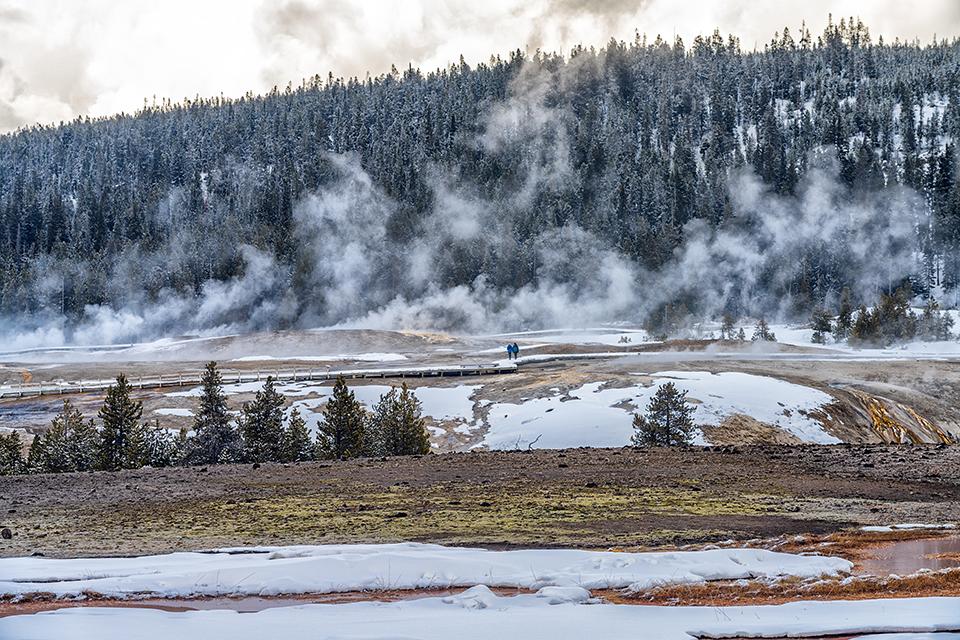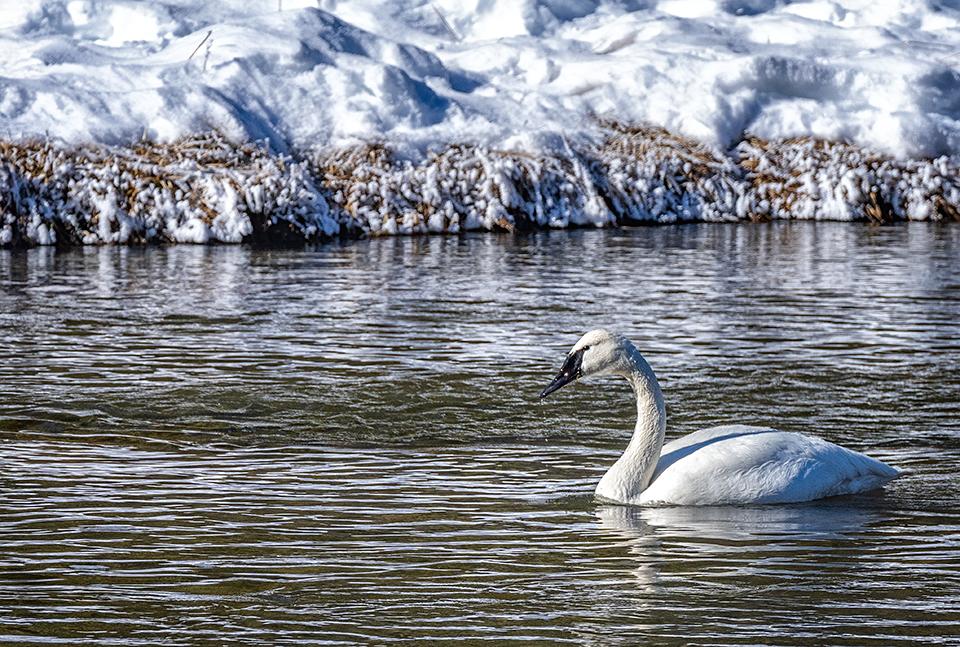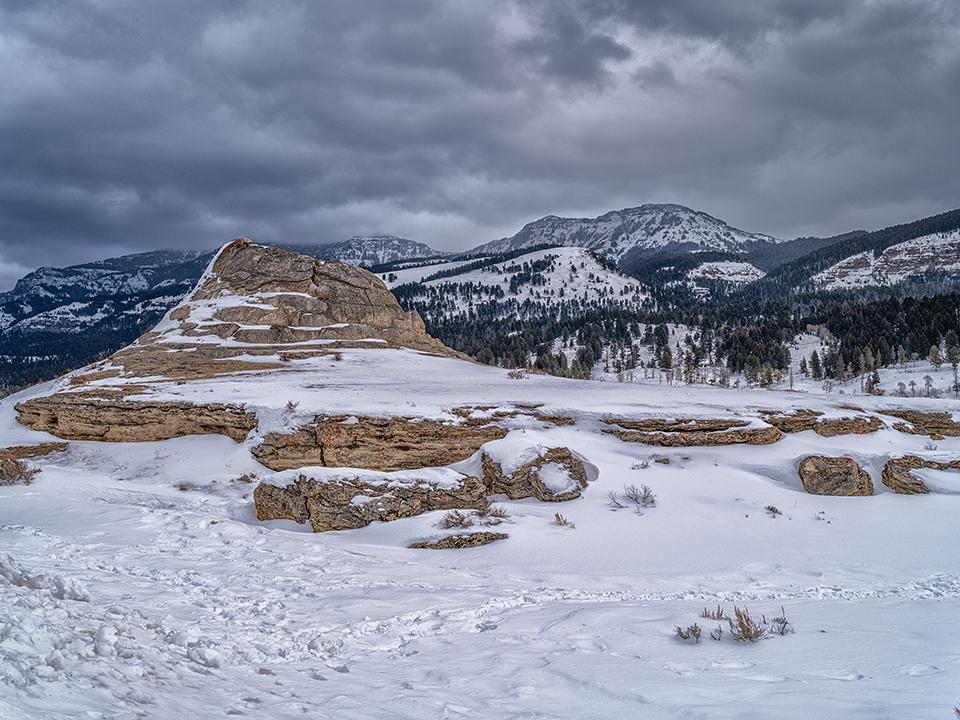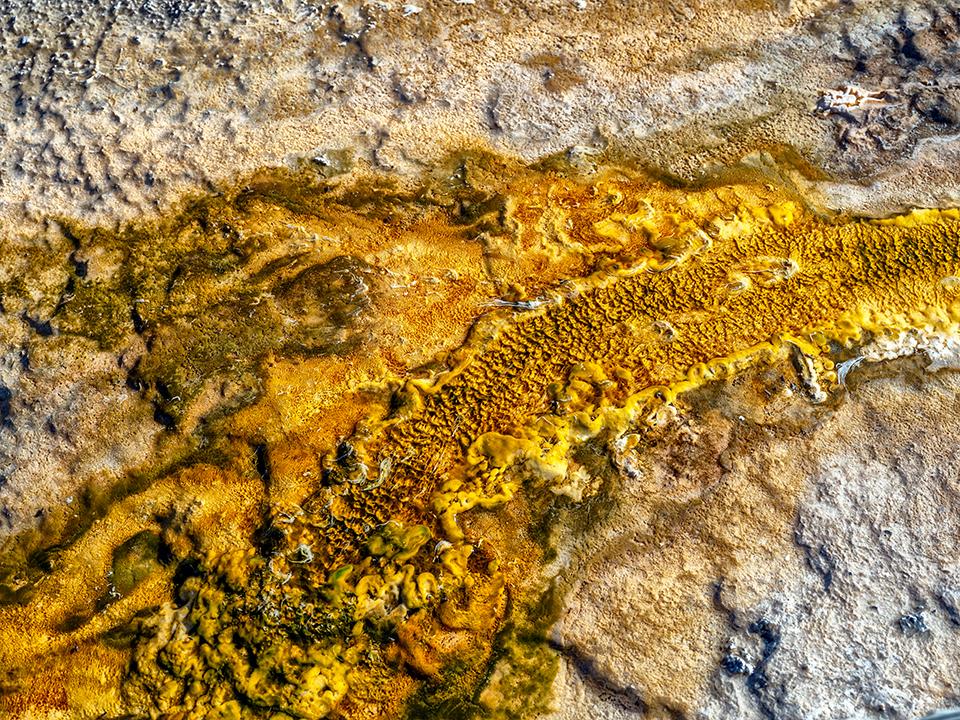
Taking a walk around Upper Geyser Basin, Yellowstone National Park / Rebecca Latson
March is the anniversary month of Yellowstone National Park, which turns 150 this year (you don’t look a day over 100, wink wink). This quiz and trivia piece is all about Yellowstone. How much do you really know about the world’s first national park? Test your knowledge before checking the answers at the bottom of the page.

A snowcoach on the snow, Yellowstone National Park / Rebecca Latson
1. With the exception of the road from the north to the northeast entrance of the park, all the other roads are closed to personal vehicles during the winter. To get around the interior, snowcoaches or snowmobiles are the modes of transportation for park visitors. Those huge, rugged tires on the snowcoaches are kept inflated to ___ psi for driving over the snowy roads.
a) 10 psi
b) 13 psi
c) 17 psi
d) 25 psi
2. Let’s stick with snowcoaches a little longer. True or False: snowcoaches need groomed roads for good maneuverability.
a) True
b) False
3. Visitation to Yellowstone in the winter is about ___ percent of what visitation is during the summer.
a) one
b) three
c) five
d) seven

Lodgepole pines at Norris Basin, Yellowstone National Park / Rebecca Latson
4. Eighty percent of Yellowstone National Park is forested, and of that percentage, ____ percent of all the forests are lodgepole pines.
a) 20%
b) 40%
c) 60%
d) 80%

Excelsior Geyser Crater discharge flowing into the Firehole River, Yellowstone National Park / Rebecca Latson
5. During the 1880s, Excelsior Geyser Crater was once an active geyser that spouted steam and water as high as 300 feet and equally as wide. Then, it essentially blew itself up and stopped erupting until 1985. Then, it stopped erupting again. What this geyser does do is discharge ____ gallons of water per minute, daily, into the Firehole River.
a) 2,500
b) 3,000
c) 4,000
d) 4,500
6. True or False: despite the influx of warm waters from various thermal features, the Firehole River still freezes at some point in time during the winter.
a) True
b) False

A trumpeter swan floating along the Firehole River, Yellowstone National Park / Rebecca Latson
7. One of the birds you might see plying the water of the Firehole River is the trumpeter swan. This regal-looking bird has a wingspan of about ___ feet.
a) five
b) six
c) seven
d) eight
8. True or False: Upper Geyser Basin is considered to be more acidic than any of the other geyser basins.
a) True
b) False

Soda Butte and the Absaroka Mountains, Yellowstone National Park / Rebecca Latson
9. As you drive the length of Lamar Valley, turning north-northeast toward the Absaroka Mountain Range, you’ll see an odd feature just off the side of the road known as Soda Butte. True or False: Soda Butte is the lone thermal feature in the northeastern part of the park.
a) True
b) False

A thermal feature along the Gibbon River, Yellowstone National Park / Rebecca Latson
10. As you travel parallel to the Gibbon River, between Norris Basin and Madison, you’ll notice some unique thermal cones about three-to-five feet tall, steaming along the riverbanks, in variegated colors of brown, yellow, and brick red. These thermal features go by the nickname ___.
a) Fondue pots
b) Coffee pots
c) Chocolate pots
d) Chocolate ice cream cones
Trivia

Ephydrid fly larvae and adults, Biscuit Basin, Yellowstone National Park / Rebecca Latson
As you walk along the boardwalks at Biscuit Basin, look down to the yellow-orange bacterial mats at your feet. You might notice clumps of black rice-shaped specks in the bacterial mats. These specks are larvae of ephydrid flies. “Some of the cooler thermal run-off channels pulse with activity due to tiny winged insects called ephydrid (ef-id-rid) flies. These flies mate in the hot springs and their larvae devour the bacteria and other microorganisms of the hydrothermal areas. The flies are active even in winter because the thermal water creates a year-round summer climate. The adults can’t live in temperatures greater than about 109 degrees Fahrenheit (43 degrees C); however, they go partway underwater insulated by a bubble of air in order to feed in hotter water.”

Bison grazing near Blacktail Pond, Yellowstone National Park / Rebecca Latson
Yellowstone is the only place in the United States where bison (Bison bison) have lived continuously since prehistoric times. “Yellowstone bison are exceptional because they comprise the nation’s largest bison population on public land. Unlike most other herds, this population has thousands of individuals that are allowed to roam relatively freely over the expansive landscape of Yellowstone National Park and some nearby areas of Montana. They also exhibit wild behavior like their ancient ancestors, congregating during the breeding season to compete for mates, as well as migration and exploration that result in the use of new habitat areas. These behaviors have enabled the successful restoration of a population that was on the brink of extinction just over a century ago.”

Colorful thermophiles, Biscuit Basin, Yellowstone National Park / Rebecca Latson
Thermophiles (heat-loving microorganisms) are more than just pretty, colorful faces spreading out from geysers or hot springs. One particular thermophile, Thermus aquaticus, discovered in one of the hot springs of Yellowstone National park, revolutionized DNA replication processes. “Until the 1980s, our ability to study DNA was limited. Things we take for granted today such as DNA fingerprinting to identify criminals, DNA medical diagnoses, DNA-based studies of nature, and genetic engineering did not exist. But in 1985, the polymerase chain reaction (PCR) was invented. PCR is an artificial way to do something that living things do every day—replicate DNA … it allows scientists to make billions of copies of a piece of DNA in a few hours. Without PCR, scientists could not make enough copies of DNA quickly enough to perform their analyses. However, the heat necessary to do the PCR process inactivated the enzymes making the process extremely slow and expensive. They found the solution to this problem in one of the hot spring organisms isolated from Yellowstone by park researcher Thomas Brock in the 1960s; Thermus aquaticus. An enzyme discovered in T. aquaticus—called Taq polymerase—made PCR practical. Because it came from an extremophile, Taq polymerase can withstand the heat of the PCR process without breaking down like ordinary polymerase enzymes.” To read more about “bioprospecting” – the discovery of useful scientific information from genetic or biochemical resources, click here.
Quiz Answers
1b
According to three different snowcoach drivers with whom I rode, the tires of these large vehicles are kept around 13 psi, which spreads the tire’s footprint for a better grip on the snowy roads.
2a True
According to two snowcoach drivers, grooming the park roads is very important for snowcoach maneuverability. If the snowcoaches drive on non-groomed roads (ex. If a snowfall occurred overnight in the park), the snowcoaches are liable to get stuck in the snow, more often than not.
3c
Winter visitation to Yellowstone is about five percent of what it is in the summer.
4d
Eighty percent of Yellowstone is forested, and of that percentage, 80 percent of all the forests are lodgepole pines. “Lodgepole pines prefer slightly acidic soil, and will grow quickly in mineral soils disturbed by fire or by humans, such as where a road has been cut into the forest. Their roots spread out sideways and do not extend deeply into the soil—an advantage in Yellowstone where the topsoil is only about 6 to 12 inches deep, but a disadvantage in high winds. Lodgepole pines are vulnerable in windstorms, especially individuals that are isolated or in the open.” To learn more about the forests of Yellowstone, click here.
5c
Excelsior Geyser Crater “constantly discharges more than 4,000 gallons of water per minute into the Firehole River.” Although it ceased erupting after 1890, it “roared back to life with 47 hours of major eruptions in 1985.” Needless to say, it is difficult to determine when “this dormant but powerful geyser’s next eruption will occur.”
6b False
Because of the discharge of warm water from such thermal features as Excelsior Geyser Crater, the Firehole River does not freeze, which is why this river is such a great birding and wildlife viewing area.
7d
The trumpeter swan “is North America’s largest wild waterfowl, with a wingspan of up to eight feet.” It’s one of the birds you’re likely to see swimming the Firehole River in the winter. To learn more about the trumpeter swan, click here.
8b False
The distinction of being the most acidic goes to Norris Geyser Basin, which is also considered to be hotter than any of the other geyser basins. “The highest temperature yet recorded in any geothermal area in Yellowstone was measured in a scientific drill hole at Norris: 459°F (237°C) just 1,087 feet (326 meters) below the surface! There are very few thermal features at Norris under the boiling point (199°F at this elevation).”
9a True
The lone thermal feature in the northeastern portion of the park, Soda Butte is a “travertine calcium carbonate mound formed more than a century ago by a hot spring. Only small amounts of hydrothermal water and hydrogen sulfide gas [which you can definitely smell] currently flow from this once, more prolific, spring.”
10a
Averaging a temperature of about 130 degrees Fahrenheit, these cones, nicknamed “chocolate pots,” may be seen along the Gibbon River between Norris Geyser Basin and Madison. The rich coloration is a combination of mineral oxides (iron, nickel, aluminum, manganese) and warm water-loving algae and bacteria.
References
In addition to the information from each NPS.gov park website, I used the following references.
Janet Chapple, Yellowstone Treasures: The Traveler’s Companion to the National Park, fifth printing, 2017, Granite Peak Publications
Janet Spencer, Yellowstone Trivia, 2006, Riverbend Publishing
https://www.yellowstonenationalpark.com/gibbongeyserbasin.htm



Add comment